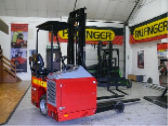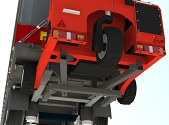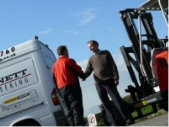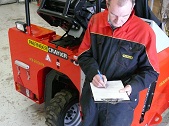|
The specification of the trailer, and in particular the positioning of the axles, will have a large influence on the kingpin weight. To get the maximum kingpin weight the axles need to be as far to the rear of the trailer as possible. The restriction of this comes with the length of trailer due to having to comply with UK turning circle regulations (Construction and Use regulations 1986). An articulated vehicle is deemed to meet these regulations if the distance from the kingpin to the centre line of the non-steering bogie does not exceed 8.135m for a 2.55m wide vehicle. This creates the problem for maximum length trailers as the only way to increase the bed length is to increase the overhang (unless steering axles are used). Increasing the overhang amplifies the weight of the forklift and so removes more weight from the kingpin. This subsequently results in more counter balance weight being required.
The first question to ask is do you need to have a full length trailer to carry your maximum load? The payload of the trailer has been reduced by the weight of the forklift and in addition any counterbalance weight added. With this in mind, for some applications the trailer can reach maximum gross weight before the maximum bed space has been utilised. In these applications the best solution can be to have a shorter trailer (reduced rear overhang) as this will reduce the tare weight of the unladen trailer, reduce (or completely alleviate) the need for a counter-balance weight and improve manoeuvrability.
In applications where longer or full length trailers are required then the amount of counterbalance weight required will depend on the size of forklift. For larger forklifts specialist trailer design can be considered, for example a rear steering axle can be used to allow the use of a front lift axle and the positioning of the axles further to the rear of the trailer while still complying with the turning circle regulations. Although this type of trailer specification will be more expensive than a standard design, cost savings over the life of the trailer including reduced tyre wear and increased payload can more than justify the investment.
|








